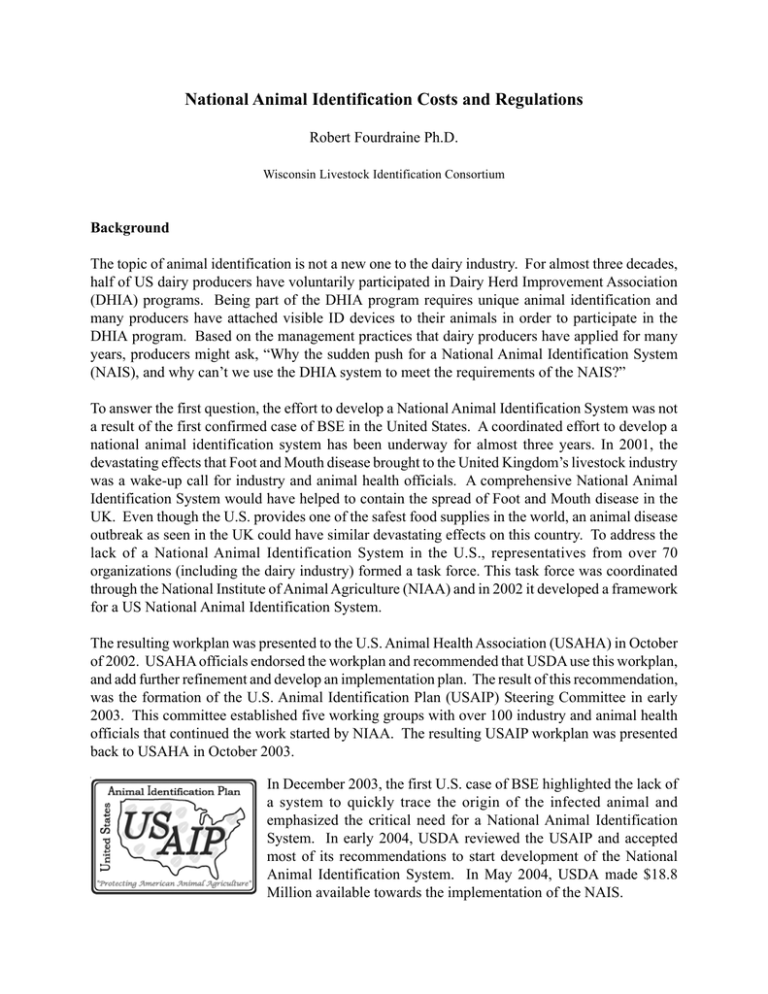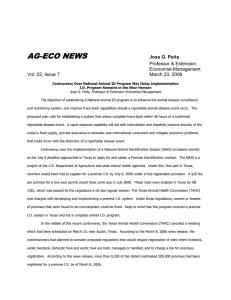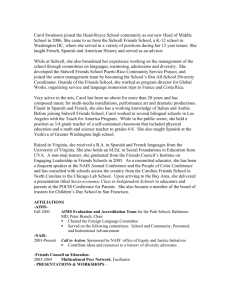National Animal Identification Costs and Regulations
advertisement

National Animal Identification Costs and Regulations Robert Fourdraine Ph.D. Wisconsin Livestock Identification Consortium Background The topic of animal identification is not a new one to the dairy industry. For almost three decades, half of US dairy producers have voluntarily participated in Dairy Herd Improvement Association (DHIA) programs. Being part of the DHIA program requires unique animal identification and many producers have attached visible ID devices to their animals in order to participate in the DHIA program. Based on the management practices that dairy producers have applied for many years, producers might ask, “Why the sudden push for a National Animal Identification System (NAIS), and why can’t we use the DHIA system to meet the requirements of the NAIS?” To answer the first question, the effort to develop a National Animal Identification System was not a result of the first confirmed case of BSE in the United States. A coordinated effort to develop a national animal identification system has been underway for almost three years. In 2001, the devastating effects that Foot and Mouth disease brought to the United Kingdom’s livestock industry was a wake-up call for industry and animal health officials. A comprehensive National Animal Identification System would have helped to contain the spread of Foot and Mouth disease in the UK. Even though the U.S. provides one of the safest food supplies in the world, an animal disease outbreak as seen in the UK could have similar devastating effects on this country. To address the lack of a National Animal Identification System in the U.S., representatives from over 70 organizations (including the dairy industry) formed a task force. This task force was coordinated through the National Institute of Animal Agriculture (NIAA) and in 2002 it developed a framework for a US National Animal Identification System. The resulting workplan was presented to the U.S. Animal Health Association (USAHA) in October of 2002. USAHA officials endorsed the workplan and recommended that USDA use this workplan, and add further refinement and develop an implementation plan. The result of this recommendation, was the formation of the U.S. Animal Identification Plan (USAIP) Steering Committee in early 2003. This committee established five working groups with over 100 industry and animal health officials that continued the work started by NIAA. The resulting USAIP workplan was presented back to USAHA in October 2003. In December 2003, the first U.S. case of BSE highlighted the lack of a system to quickly trace the origin of the infected animal and emphasized the critical need for a National Animal Identification System. In early 2004, USDA reviewed the USAIP and accepted most of its recommendations to start development of the National Animal Identification System. In May 2004, USDA made $18.8 Million available towards the implementation of the NAIS. The answer to the second question (why can’t we use the DHIA system to meet the requirements of the NAIS?) is more complex. The dairy industry has almost 50% of its animals recorded within the DHIA database. These animals are identified and the link to a DHIA herdcode can identify the current location; however, the requirements for identifying animals from various species and recording the movement of animals from farm through livestock markets to slaughter go beyond the current capabilities of the DHIA system. The DHIA system was designed to collect production management information and provide information to improve herd management and genetic programs. Because of the animal identification efforts, it has been well recognized that the DHIA system can be a major contributor to the implementation of the NAIS in the dairy industry. This document will focus on the NAIS implementation plan (including cattle species recommendations), plus the required steps that are anticipated for dairy producers to participate. Implementation plan The goal of the NAIS is to achieve a traceback system that can identify all animals and premises potentially exposed to an animal with a foreign animal disease (FAD) within 48 hours after discovery. To achieve this goal implementation is broken up into three major steps: 1) Premises registration 2) Animal Identification 3) Animal Tracking Step 1) Premises registration Premises registration is the first step in implementing the NAIS. Premises registration involves the identification of locations where animals are produced, housed, held, or managed. Each premises is assigned a 7character unique national identifier. The rules and regulations by which a premises is registered is the authority of each State Department of Agriculture. Each state will be required to collect several basic pieces of information such as a contact name for the premises, address, phone number, and type of premises (farm, livestock market, etc) that will be stored in a state database. A subset of the state collected data will be uploaded to a national database. States with branding laws could include the process of registering a premises within the process of registering a brand. Step 2) Animal Identification Obtaining ID tags: In order to individually identify animals, producers will have to obtain an official ID device. To meet the 48-hour goal, the cattle industry recommended the use of RFID eartags as the most practical solution to identify cattle and track their movement. For a producer to obtain official ID devices they must have obtained a premises ID and present this to the distributor of the ID tags. The ID tag distributor is required to send a record of the animal ID numbers allocation to the premises to the state or national animal ID database. Tag application: At this time, the cattle industry recommendation does not require a producer to apply the tag until the animal leaves the farm. From a production management perspective, the dairy industry recommends that animals are tagged at birth and a secondary ID tag is applied and cross referenced with the official ID tag. A second ID tag properly cross-referenced will ensure that proper ID can be maintained in the case the official ID tag is lost. Even though RFID eartags enjoy a high retention rate, there will be an acceptable level of lost tags. In order to least inconvenience producers, the recommendation is that a new replacement RFID eartag must be applied before the animal leaves the farm. Assuming the producer knows the previous individual ID number, a record can be sent to the national database that cross references the old and new individual animal ID. Step 3) Animal Tracking The process of reporting animal movement is not new, depending on the state and animal disease status, currently there are rules and regulations in place that already require recording of movement. Existing processes will be adapted so they include the new standards for premises and animal identification numbers. Even though a large group of animals is being tracked, there is an even larger group of animals that is not being tracked. The use of RFID tags offers the opportunity to automate the process of recording individual animal ID numbers. Animals moving through livestock markets and slaughter facilities most likely will be electronically read through stationary RFID readers. However, recording of animal ID numbers for animals moving from farm to farm will be more challenging. Producers would need to obtain equipment to read the RFID eartag and report information to the state or national database. For those animals that are not recorded through any regulatory processes, the cattle industry recommends that the buyer is responsible for the reporting of animal movement to the state or national database. It is envisioned that the DHIA system can provide the producer with a service that has the ability to record and report animal movement thus limiting the extra effort required by the producer. Costs The costs associated with establishing the National Animal Identification System will be substantial. It is highly unlikely that states and/or federal government will pay for the complete cost of establishing the NAIS. Depending on the recommendations of each species group, costs associated with establishing the NAIS can vary tremendously. Costs to the industry can be broken up in three major categories: - Information Technology (IT) infrastructure - Identification devices - Data collection IT Infrastructure: The USAIP outlines the information system components that need to be developed to store the premises and animal ID information at the state and federal level. USDA has received startup funding to establish the information system outlined in the USAIP. It is envisioned that continued funding will be provided to USDA and states to continue development, provide support and maintain the information system. ID Devices: Based on the fact that the cattle industry has recommended Radio Frequency ID (RFID) eartags as the preferred means of individually identifying animals, the largest component in terms of cost towards the NAIS is the ID device component. Industry has recommended that only tamperproof RFID eartags that meet the ISO 11784 standard can be used. Current cost of RFID tags that can meet these specifications range from $1.75 to $2.50 per tag. Price varies based on the manufacturer and type of RFID eartag. The USAIP includes a cost estimate for RFID tags and industry requested federal funding would be provided to producers to purchase RFID tags. USDA has adopted the position of being technology neutral and is allowing the industry to select the ID technologies most practical and cost effective. Given this position, at this time it is unlikely USDA will make funding available towards the purchase of any type of ID device. Unless industry decides to adopt an ID device that is cheaper then a RFID eartag, dairy producers are looking at an additional cost of approximately $2.00 per newborn animal (includes females and males), Since dairy producers apply visible ID tags, it is not envisioned that there would be a significant cost increase in regards to applying the RFID eartag. Data collection: Industry recognizes that there will be a cost to producers in regards to data collection. These costs may range from fees associated with registering a premises, purchase of equipment used to read the RFID eartags, to costs associated with the reporting of animal movement information. Certain states may charge a small annual fee to register a premises. States with branding laws may include premises registration with the process of brand registration. Equipment costs may vary depending on the type of equipment a dairy producer would choose to use. A battery operated RFID reader that will read a RFID eartag and show the RFID eartag number on a digital display can be purchased for as little as $100. Depending on the level of integration of RFID eartags in daily herd management and performance of the RFID reader required, the cost of an RFID reader may increase to as much as $2000. This type of a reader would include a handheld computer equipped with RFID reader. The biggest variable in terms of data collection are costs associated with the reporting of animal movement. As mentioned earlier, DHIA can provide producers with a valuable service beyond herd management, several DHIA’s have expressed interest in reporting animal movement to the NAIS. It is also envisioned that herd management software providers will include capabilities within their software that will allow the software user to provide data to the NAIS. At this time, it is unknown if DHIA or herd management software providers will charge an additional per cow fee or fixed fee for providing this added service. Regulations Even though participation in the NAIS is currently voluntary, there are existing requirements in terms of interstate movement of animals. In addition to federal regulations, certain states may have requirements in regards to intrastate movement of animals. Existing methods for recording animal movement such as the interstate certificate of veterinary inspection will be integrated in the NAIS. In addition to existing federal and state regulations, states may impose new regulations towards implementation of the NAIS at the state level. Several states are in the process of making it mandatory to register premises for all livestock producers. Dairy producers currently are required to obtain a milk permit and the process of registering a premises could easily be added to the milk permit renewal process. Benefits Although the focus of the NAIS is animal health, an animal ID system that is designed to protect the health of the livestock industry may open up opportunities for the dairy industry to improve herd management. It has been well recognized that a national animal ID system would improve the national dairy genetic programs. However, one of the most exciting opportunities is the integration of RFID eartags in daily herd management. RFID eartags would allow for the automation of data collection. Integration could include, but not be limited to electronic collection of milk weights, electronic collection of animal weights using weigh scales, use of RFID eartags in dispensing feed from feeding stations, and recording individual cow data using handheld computers. The additional costs of using RFID eartags could be offset by gains made in herd management or by simply replacing electronic neck or leg transponders with RFID eartags. Aside from benefits in daily herd management, a national animal identification system could provide opportunities for product marketing. An animal ID system that provides a link to farm of origin could provide the infrastructure to support value-added programs. Conclusions The need for a national animal identification system (NAIS) to protect the health of the national livestock industry is clear. Industry working together with state and federal animal health officials has resulted in an implementation plan for the NAIS. Even though the implementation plan has addressed many issues, several issues remain. The four main issues facing the industry will be cost, confidentiality, technology, and mandatory versus voluntary compliance. The cost of implementing the NAIS will be substantial, and it is almost a foregone conclusion that a cost share program between public and private funds will be needed to implement the NAIS. The level of contribution from public funds will affect the speed by which the NAIS is implemented and the level of tracking that will be available. Aside from cost, confidentiality is an item of concern to many producers. Unless the industry provides all funds to implement the NAIS and also maintains the information system, legislation at both the state and federal level will be required to protect the data collected from the Freedom of Information Act (FOIA). States that are moving towards mandatory participation in the NAIS are addressing confidentiality in the legislation; however, federal legislation or other means to protect the data from FOIA is also needed. To meet the 48 hour goal outlined in the USAIP, the cattle industry recommends the use of RFID technology. Even though RFID technology has been around for many years, challenges remain in terms of tag retention, reader technologies, and integration within the livestock markets. Industry recognized that implementation projects are needed to integrate RFID technology in different environments. Assuming that cost, confidentiality, and technology issues are resolved, many producers are skeptical that the NAIS will not be effective unless participation in the NAIS is made mandatory. Other countries that have established a mandatory national animal ID system started on a voluntary basis, but participation became mandatory after implementation issues were resolved. In conclusion, unless there are financial benefits or a deadline by which the NAIS becomes mandatory, a high level of participation in a voluntary NAIS is unlikely. Dairy producers are well aware of good herd management practices and the role animal health plays in being profitable; therefore, dairy producers are most likely to be early adopters of the NAIS.







